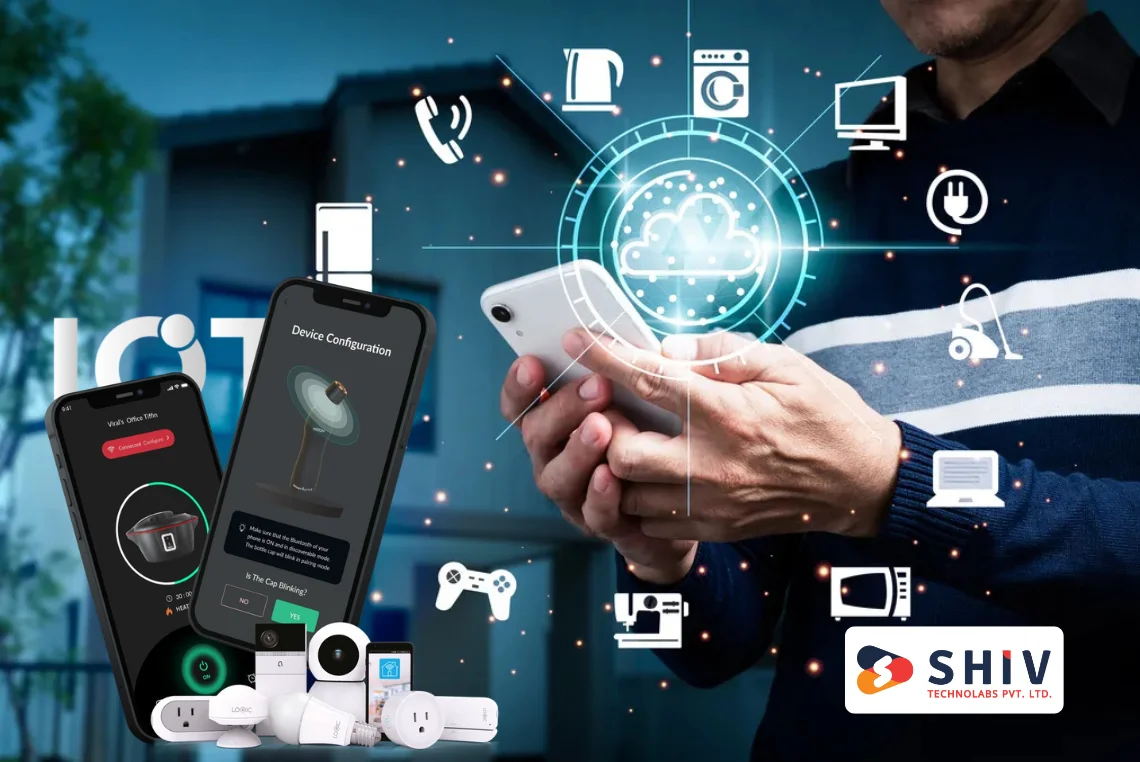Table of Contents
IoT in Healthcare means using smart devices to help patients and doctors. These devices can send health information, such as blood pressure or heart rate, in real time. This helps doctors find problems early. It also lets people get care at home instead of in the hospital.
Many hospitals will use this new technology by 2025. About 74% of U.S. patients now use telehealth tools connected by IoT. The global IoT market in healthcare will be nearly $65 billion in 2025.
It grows fast, by about 21% each year. This guide explains how IoT in healthcare works, its benefits, challenges, and real examples. We will see how hospitals can hire IoT developers for healthcare and use IoT consulting services for hospitals. By the end, you will see why smart healthcare technology is important and how to use it.
What Does IoT in Healthcare Mean?

IoT in Healthcare refers to connected gadgets that gather, transfer, and exchange medical information over the web. These devices keep medical professionals and patients connected at all times.
# Key Functions of IoT in Healthcare:
- Watches important body signs like pulse, blood pressure, and blood sugar.
- Alerts medical staff when urgent situations happen.
- Monitors patients remotely, reducing hospital visits.
- Locates equipment like wheelchairs or IV pumps in real-time.
# Common IoT Devices in Use:
| Device Type | Function | Example Use Case |
|---|---|---|
| Wearable Sensors | Monitor heart rate, oxygen, sleep | Smartwatches, fitness bands |
| Remote Health Monitors | Track BP, sugar, ECG from home | Connected BP monitors, ECG patches |
| Asset Trackers | Locate hospital tools instantly | RFID tags on beds, wheelchairs |
IoT helps healthcare become more efficient, faster, and better for patients and medical staff. 83% of U.S. hospitals use the Internet of Things to check patients and equipment.
Basic Applications of IoT in Healthcare
The Internet of Things in healthcare is transforming how hospitals, nurses, and doctors operate. It allows delivering care in a better way, wastes less time, and reduces expenses. What are the main areas where IoT in Healthcare creates real results?
# Remote Patient Monitoring (RPM)
Patients are no longer required to visit hospitals or clinics. Doctors can check them virtually and offer advice.
- Devices measure blood pressure, heart rate, or sugar levels.
- These readings go directly to the doctor using internet-connected tools.
- Doctors can check progress and make fast decisions.
Hospitals now prefer custom IoT healthcare solutions for RPM. These systems are built as per the patient’s condition.
# Smart Wearable Devices
People wear smartwatches or patches that track their health 24/7.
- These devices monitor sleep, heart rate, and activity.
- If something goes wrong, alerts go to both the patient and doctor.
- It keeps people aware of their health every day.
Smart healthcare technology like this is useful for heart or diabetic patients.
# Hospital Asset Tracking
Hospitals use IoT tools to keep track of their equipment.
- Tools like wheelchairs or stretchers get tagged.
- Staff can find them quickly using a mobile app or dashboard.
This improves service speed and avoids delays.
# Medication Management
Some IoT tools help patients take their medicine on time.
- Smart pill bottles give reminders or alerts.
- Data goes to doctors to show if patients are following their schedule.
This helps reduce hospital readmissions and improves results.
# Connected Emergency Services
IoT healthcare solutions help ambulances send patient data to hospitals during emergencies.
- Doctors get real-time updates about the patient before arrival.
- They prepare the treatment in advance.
Many hospitals now hire IoT developers for healthcare to create systems that work just for them. Others take help from an IoT consulting service for hospitals to get expert advice.
These healthcare IoT applications improve treatment, speed up care, and help everyone stay healthier. A trusted healthcare IoT app development company can help build the right solution for any hospital or clinic.
Benefits of IoT in Healthcare

The IoT in Healthcare is associated with numerous advantages to hospitals, doctors, and patients. It enhances the quality of care and lowers expenses.
# Key Benefits:
- Real-Time Monitoring: Devices send live health data to doctors.
- Fewer Hospital Visits: Patients get treated at home.
- Faster Response: Alerts warn doctors about critical health signs.
- Lower Costs: Custom IoT healthcare solutions cut unnecessary tests or delays.
- Personal Care: Data helps doctors adjust treatment as per each patient’s needs.
Remote patient monitoring using IoT can reduce readmission rates by up to 30% (CDC, 2024).
Many hospitals use IoT consulting services for hospitals to plan better patient systems. Hiring an IoT healthcare solutions provider also helps set up smart care tools with less effort.
Challenges of IoT in Healthcare
Besides the benefits, there are some limitations of IoT in Healthcare
# Data Privacy and Security
Sensitive health data needs protection. IoT systems must be secured to prevent hacking.
# Integration with Existing Systems
Not all hospitals have systems that work smoothly with new IoT devices.
# High Setup Cost
Initial costs of devices and systems can be high, especially for smaller clinics.
# Data Overload
Doctors may get overwhelmed by too much data if not filtered properly.
# Battery and Connectivity Issues
Devices must have long battery life and stable internet connections to be effective.
Real-Life Examples of IoT Applications in Healthcare
Below are real-time examples of IoT Applications in Healthcare
# Apollo Hospitals – India
Using wearable ECG patches for heart patients, Apollo monitors vitals remotely and provides alerts to doctors when readings go beyond limits.
# AIIMS Delhi – Smart ICU
AIIMS launched a smart ICU project where sensors track vitals, air quality, and equipment status automatically.
# Tata Health – Home Monitoring Kit
Tata Health offers IoT-based home kits for diabetic patients to track sugar levels and send daily reports to doctors.
# Philips HealthSuite
Philips is also attaching devices such as thermometers and blood pressure monitors to a cloud platform globally, allowing doctors to access reports at any time.
The Future of IoT in Healthcare
And we predict that by 2030, even AI + IoT (AIoT) will be used more widely to provide even more intelligent diagnosis tools. Hospitals will be more automated, and patients will have more control over their health data. The situation is expected to change with government regulations and international norms that will make devices safer and data more confidential.
Conclusion
IoT in Healthcare is assisting hospitals and doctors to work intelligently. It provides quick access to patient information, enhances care and reduces cost. Healthcare IoT applications are expanding, whether it is smartwatches or sensors in hospitals. However, in order to achieve the most, you must have the strongest team.
Shiv Technolabs is a trusted IoT healthcare solutions provider. We build custom IoT healthcare solutions that are safe, simple, and smart. You can also hire IoT developers for healthcare from us, or get help through our IoT consulting services for hospitals.
Contact Shiv Technolabs today to build smart healthcare systems that work.

























